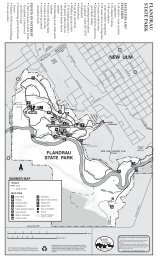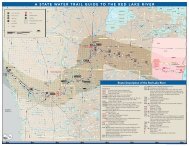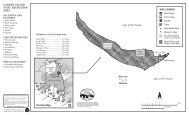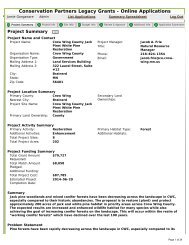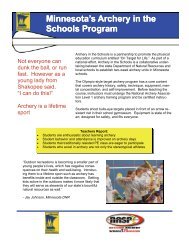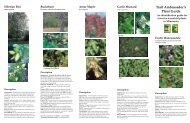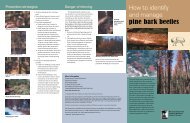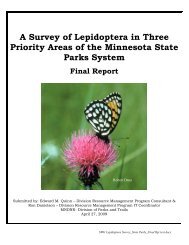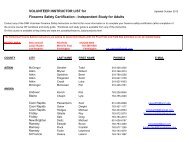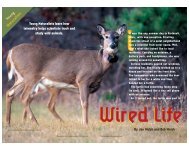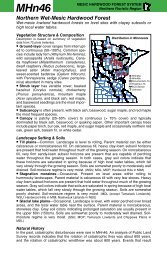Firearms safety & hunter education news: Summer 2006 - Minnesota ...
Firearms safety & hunter education news: Summer 2006 - Minnesota ...
Firearms safety & hunter education news: Summer 2006 - Minnesota ...
Create successful ePaper yourself
Turn your PDF publications into a flip-book with our unique Google optimized e-Paper software.
ALWAYS wear a Fall-Arrest System (FAS)/Full Body<br />
Harness meeting TMA Standards even during ascent and<br />
descent. Be aware that single strap belts and chest<br />
harnesses are no longer the preferred Fall-Arrest devices<br />
and should not be used. Failure to use a FAS could result in<br />
serious injury or death.<br />
ALWAYS read and understand the manufacturer’s<br />
WARNINGS & INSTRUCTIONS before using the<br />
treestand each season. Practice with the treestand at ground<br />
level prior to using at elevated positions. Maintain the<br />
WARNINGS & INSTRUCTIONS for later review as<br />
needed,<br />
for instructions on usage to anyone borrowing your stand,<br />
or to pass on when selling the treestand. Use all <strong>safety</strong><br />
devices provided with your treestand. Never exceed the<br />
weight limit specified by the manufacturer. If you have any<br />
questions after reviewing the WARNINGS &<br />
INSTRUCTIONS, please contact the manufacturer.<br />
ALWAYS inspect the treestand and the Fall-Arrest<br />
System for signs of wear or damage before each use.<br />
Contact the manufacturer for replacement parts. Destroy all<br />
products that cannot be repaired by the manufacturer<br />
and/or exceed recommended expiration date, or if the<br />
manufacturer no longer exists. The FAS should be<br />
discarded and replaced after a fall has occurred.<br />
ALWAYS practice in your Full Body Harness in the<br />
presence of a responsible adult, learning what it feels like to<br />
hang suspended in it at ground level.<br />
ALWAYS attach your Full Body Harness in the manner<br />
and method described by the manufacturer. Failure to do<br />
so may result in suspension without the ability to recover<br />
into your treestand. Be aware of the hazards associated<br />
with Full Body Harnesses and the fact that prolonged<br />
suspension in a harness may be fatal. Have in place a plan<br />
for rescue, including the use of cell phones or signal devices<br />
that may be easily reached and used while suspended. If<br />
rescue personnel cannot be notified, you must have a plan<br />
for recover/escape. If you have to hang suspended for a<br />
period of time before help arrives, exercise your legs by<br />
pushing against the tree or doing any other form of<br />
continuous motion. Failure to recover in a timely manner<br />
could result in serious injury or death. If you do not have<br />
the ability to recover/escape, hunt from the ground.<br />
Treestand Safety Guidelines<br />
Promoting Treestand Safety Sponsored By TMA<br />
P.O. Box 15214 Hattiesburg, MS 39404-5214 Phone 601-584-7983<br />
Fax 601-584-9220 e-mail http://www.tmastands.com<br />
Save and insert in<br />
your Instructor<br />
Manual<br />
ALWAYS hunt with a plan and if possible a buddy.<br />
Before you leave home, let others know your exact hunting<br />
location, when you plan to return and who is with you.<br />
ALWAYS carry emergency signal devices such as a cell<br />
phone, walkie-talkie, whistle, signal flare, PLD (personal<br />
locator device) and flashlight on your person at all times<br />
and within reach even while you are suspended in your<br />
FAS. Watch for changing weather conditions. In the event<br />
of an accident, remain calm and seek help immediately.<br />
ALWAYS select the proper tree for use with your<br />
treestand. Select a live straight tree that fits within the size<br />
limits recommended in your treestand’s instructions. Do<br />
not climb or place a treestand against a leaning tree. Never<br />
leave a treestand installed for more than two weeks since<br />
damage could result from changing weather conditions<br />
and/or from other factors not obvious with a visual<br />
inspection.<br />
ALWAYS use a haul line to pull up your gear and<br />
unloaded firearm or bow to your treestand once you have<br />
reached your desired hunting height. Never climb with<br />
anything in your hands or on your back. Prior to<br />
descending, lower your equipment on the opposite side of<br />
the tree.<br />
ALWAYS know your physical limitations. Don’t take<br />
chances. If you start thinking about how high you are, don’t<br />
go any higher.<br />
NEVER use homemade or permanently elevated stands<br />
or make modifications to a purchased treestand without the<br />
manufacturer’s written permission. Only purchase and use<br />
treestands and Fall-Arrest Systems meeting or exceeding<br />
TMA standards. For a detailed list of certified products,<br />
contact the TMA office or refer to the TMA web site at<br />
http://www.tmastands.comwww.tmastands.com.<br />
NEVER hurry!! While climbing with a treestand, make<br />
slow, even movements of no more than ten to twelve inches<br />
at a time. Make sure you have proper contact with the tree<br />
and/or treestand every time you move. On ladder-type<br />
treestands, maintain three points of contact with each step.<br />
Anytime You’re More than 3 Feet off the ground,<br />
PLEASE follow these Guidelines…<br />
It could save You from injury or death !!!<br />
Volume 27 Page 11



